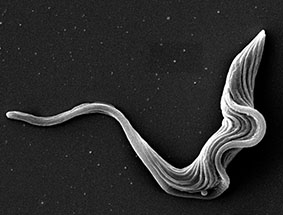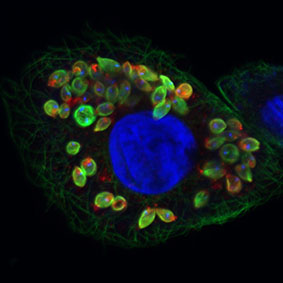Biography
 I graduated from the University of Leeds with a BSc. (Hons.) degree in Applied Zoology. I was awarded a PhD in 1997 following research at Bangor University on a vaccine candidate for the human parasite Schistosoma mansoni. In my first research position, I studied novel genes involved in chromosome translocations in B-cell malignancies at the Institute of Cancer Research, Surrey. I returned to the field of parasitology in 2000 to join the research group of Debbie Smith at Imperial College London and from 2004 at the University of York, studying the cell biology of the protozoan parasites Leishmania major and Trypanosoma brucei. I performed molecular studies to validate the enzyme N-myristoyltransferase (NMT) as a drug target and used protozoa as genetically tractable model organisms to study the functions of proteins implicated in human genetic and autoimmune diseases. I relocated to Keele as Lecturer in Bioscience in September 2013 and was promoted to Senior Lecturer in 2018, to Reader in 2020 and to Professor in 2022. I run a research group focusing on kinetoplastid parasites and co-lead the NIHR-funded ECLIPSE research programme with Professor Lisa Dikomitis. I have been the Director for Research for the School of Life Sciences since September 2020.
I graduated from the University of Leeds with a BSc. (Hons.) degree in Applied Zoology. I was awarded a PhD in 1997 following research at Bangor University on a vaccine candidate for the human parasite Schistosoma mansoni. In my first research position, I studied novel genes involved in chromosome translocations in B-cell malignancies at the Institute of Cancer Research, Surrey. I returned to the field of parasitology in 2000 to join the research group of Debbie Smith at Imperial College London and from 2004 at the University of York, studying the cell biology of the protozoan parasites Leishmania major and Trypanosoma brucei. I performed molecular studies to validate the enzyme N-myristoyltransferase (NMT) as a drug target and used protozoa as genetically tractable model organisms to study the functions of proteins implicated in human genetic and autoimmune diseases. I relocated to Keele as Lecturer in Bioscience in September 2013 and was promoted to Senior Lecturer in 2018, to Reader in 2020 and to Professor in 2022. I run a research group focusing on kinetoplastid parasites and co-lead the NIHR-funded ECLIPSE research programme with Professor Lisa Dikomitis. I have been the Director for Research for the School of Life Sciences since September 2020.
Image: Scanning electron micrograph of Trypanosoma brucei bloodstream form parasite
Research and scholarship
 My research focuses on understanding the cell biology of the protozoan parasites Leishmania spp. and Trypanosoma brucei and exploiting this knowledge towards the development of new therapeutics. Current projects include the following:
My research focuses on understanding the cell biology of the protozoan parasites Leishmania spp. and Trypanosoma brucei and exploiting this knowledge towards the development of new therapeutics. Current projects include the following:
- Investigating the functions of the BBSome protein complex in Leishmania mexicana using molecular, cellular and proteomic techniques. This work is being performed in collaboration with co-investigator Dr Sarah Hart and is funded by the MRC.
- Study on Trypanosoma evansi, a major pathogen of camels in North Africa. In collaboration with Professor Somaia Abou-Akkada at Alexandria University, Egypt, we are investigating the prevalence of T. evansi in Egyptian camels and analysing isolated parasites for drug resistance against commonly used anti-trypanocidal drugs. We are also undertaking work to identify novel compounds with specific activity against T. evansi. This work is funded by a Newton Fund/Mosharafa Institutional Links grant, administered by the British Council and STDF.
- I am also investigating the potential use of magnetic and gold hybrid nanoparticles as novel therapies for cutaneous leishmaniasis, in collaboration with Professor Neil Telling and Dr Clare Hoskins.
I am co-leading the ECLIPSE programme with Professor Lisa Dikomitis, medical anthropologist at the University of Kent. This is a four-year £4.6M project funded by the UK's National Institute for Health Research (NIHR), which aims to reduce stigma and improve the patient journey for people living with cutaneous leishmaniasis in Brazil, Ethiopia and Sri Lanka.
Image: Macrophage infected with Leishmania major amastigotes (Molecular Microbiology Vol. 90, November 2013)
Teaching
Level 5
- LSC-20073 Microbes, Viruses and Parasites (Module Lead)
Level 6
- LSC-30009 Clinical Pathology
- LSC-30015 Biology of Disease
- LSC-30035 Double Biochemistry Research Project
Postgraduate
- MSc. Biomedical Blood Science
- LSC-40017 Introduction to Scientific Research
Publications
Grants and Admin
Research funding
- EPSRC/GCRF research grant (co-I), Patient-centric supramolecular formulations of new antileishmanial drugs for Indian Communities, £906,252. 2020-2022.
- NIHR RIGHT (co-PI), Empowering people with cutaneous leishmaniasis: intervention programme to improve patient journey and reduce stigma via community education (ECLIPSE), £4,576,819. 2019-2023.
- Newton Fund Institutional Links grant (British Council/Mosharafa) (PI), Investigating drug resistance and new treatments for Trypanosoma evansi infection in Egyptian camels. 2017-19, £171,647.
- MRC New Investigator Research grant (PI), BBSome trafficking: investigating a novel pathway associated with virulence in Leishmania. 2017-21, £438,690.
- EPSRC RCUK Public Engagement with Research Catalysts (Co-I), Co-production and Creativity: ethos, typologies and innovation in public engagement practice. 2017-18, £57,117.
- Wellcome Trust Seed Award (PI), Nanoparticle-induced hyperthermia as a Novel Therapy for Cutaneous Leishmaniasis. 2015-17, £92,606.
- Keele University Acorn PhD studentship (PI), ARF protein regulators as novel drug targets in Trypanosoma brucei. 2015-18, £55,209.
- Royal Society research grant (PI), Functions & interactions of BBS1, novel virulence factor in the human pathogen Leishmania. 2014-15, £14,159.
Academic leadership roles
- Research Director for the School of Life Sciences (Sept 2020-present)
- Deputy Director for Postgraduate Research for the Faculty of Natural Sciences, Keele (2018-2020)
- Postgraduate Research Lead for the School of Life Sciences (2016-2020)
- GCRF Lead for the Faculty of Natural Sciences, Keele (2020)
- Chair of the Keele University Genetic Modification Safety Sub-Committee (2018-21)
- Vice-Chair of Keele University Ethical Review Panel 3 (ERP3) (2014-17)
- Elected member of Keele University Senate (2016-19)
- Member of the Keele University Advisory Group for Public Engagement and the Faculty of Natural Sciences outreach strategy group (2018-present)
External professional activities
- Honorary Communications Secretary for the British Society for Parasitology (2018-21)
- Deputy Editor for PLoS NTD (2020-present)
- Review Editor in Understanding Health for the journal Frontiers in Young Minds
- External Examiner for the MSc Tropical Disease Biology programme at Liverpool School of Tropical Medicine (2018-present)
- Blogger for the BugBitten site (http://blogs.biomedcentral.com/bugbitten/)
School of Life Sciences,
Huxley Building,
Keele University,
Staffordshire,
ST5 5BG
Tel: +44 (0) 1782 734414
Enquiries:
Tel: +44 (0) 1782 734414
Email: lifesciences.office@keele.ac.uk


